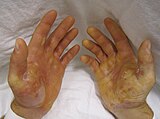| Epidermolysis bullosa simplex | |
|---|---|
 | |
| Epidermolysis bullosa simplex | |
| Specialty | Medical genetics |
Epidermolysis bullosa simplex (EBS) is a disorder resulting from mutations in the genes encoding keratin 5 or keratin 14. It is one of the major forms of epidermolysis bullosa, a group of genetic conditions that cause the skin to be very fragile and to blister easily.
Signs and symptoms
EBS causes blister formation at the dermal-epidermal junction. The skin blisters easily, even from very minor friction and rubbing.
Cause
Epidermolysis bullosa simplex is caused by genetic mutations that prevent the proper formation of protein structures in the skin’s epidermis. The proteins of the outer epidermis do not bond properly with those of the inner dermis layer (dermal-epidermal junction). The affected genes, KRT5 and the KRT14, which are responsible for the creation of keratin 5 and keratin 14 proteins respectively, are tied to the four major types of epidermolysis bullosa simplex. However, a small number of epidermolysis bullosa simplex patients do not have mutations in their KRT5 and KRT14 genes. Mutations in the PLEC gene are also being researched, specifically in the gene’s role in the Ogna form of epidermolysis bullosa simplex. The PLEC gene is responsible for the formation of plectin, another skin protein that attaches the epidermis to the skin’s deeper layers.
Diagnosis
Classification
Epidermolysis bullosa simplex may be divided into multiple types:
| Type | Locus & Gene | OMIM |
|---|---|---|
| Epidermolysis bullosa simplex with migratory circinate erythema | 12q13 (KRT5) | 609352 |
Epidermolysis bullosa simplex with mottled pigmentation.
|
12q13 (KRT5) | 131960 |
| Epidermolysis bullosa simplex, autosomal recessive | 17q12-q21 (KRT14) | 601001 |
Generalized epidermolysis bullosa simplex
|
17q12-q21 (KRT5), 12q13 (KRT14) | 131900 |
Localized epidermolysis bullosa simplex
|
17q12-q21 (KRT5), 17q11-qter, 12q13 (KRT14) | 131800 |
Epidermolysis bullosa herpetiformis
|
17q12-q21 (KRT5), 12q13 (KRT14) | 131760 |
Epidermolysis bullosa simplex with muscular dystrophy
|
8q24 (PLEC1) | 226670 |
| Epidermolysis bullosa simplex with pyloric atresia | 8q24 (PLEC1) | 612138 |
Epidermolysis bullosa simplex of Ogna
|
8q24 (PLEC1) | 131950 |
Management
- No cure for EB
- Treat symptoms
- Protect skin, stop blister formation, promote healing
- Prevent complications
- Necessary treatment: use oral and topical steroid for healing and prevent complication
- Maintain cool environment, avoid overheating and decreases friction
See also
References
- ^ Freedberg, et al. (2003). Fitzpatrick's Dermatology in General Medicine. (6th ed.). McGraw-Hill. ISBN 0-07-138076-0.
- Bardhan, Ajoy; Bruckner-Tuderman, Leena; Chapple, Iain L. C.; Fine, Jo-David; Harper, Natasha; Has, Cristina; Magin, Thomas M.; Marinkovich, M. Peter; Marshall, John F.; McGrath, John A.; Mellerio, Jemima E. (2020-09-24). "Epidermolysis bullosa". Nature Reviews Disease Primers. 6 (1): 78. doi:10.1038/s41572-020-0210-0. ISSN 2056-676X. PMID 32973163. S2CID 221861310.
- "Epidermolysis bullosa simplex - About the Disease - Genetic and Rare Diseases Information Center". rarediseases.info.nih.gov. Retrieved 2022-11-01.
- So, Jodi Y.; Teng, Joyce (1993), Adam, Margaret P.; Everman, David B.; Mirzaa, Ghayda M.; Pagon, Roberta A. (eds.), "Epidermolysis Bullosa Simplex", GeneReviews®, Seattle (WA): University of Washington, Seattle, PMID 20301543, retrieved 2022-11-01
- "Epidermolysis bullosa simplex: MedlinePlus Genetics". medlineplus.gov. Retrieved 2022-11-01.
- ^ James, William; Berger, Timothy; Elston, Dirk (2005). Andrews' Diseases of the Skin: Clinical Dermatology. (10th ed.). Saunders. ISBN 0-7216-2921-0.
- Harel, A, et al. "Epidermolysis Bullosa Simplex with Mottled Pigmentation Resulting from a Recurrent Mutation in KRT14." Journal of Investigative Dermatology. (2006) 126, 1654–1657. doi:10.1038/sj.jid.5700296; published online 6 April 2006.
- ^ Rapini, Ronald P.; Bolognia, Jean L.; Jorizzo, Joseph L. (2007). Dermatology: 2-Volume Set. St. Louis: Mosby. ISBN 978-1-4160-2999-1.
Further reading
External links
| Classification | D |
|---|---|
| External resources |
| Diseases of the skin and appendages by morphology | |||||||||||||||||||||||||||||||||||
|---|---|---|---|---|---|---|---|---|---|---|---|---|---|---|---|---|---|---|---|---|---|---|---|---|---|---|---|---|---|---|---|---|---|---|---|
| Growths |
| ||||||||||||||||||||||||||||||||||
| Rashes |
| ||||||||||||||||||||||||||||||||||
| Miscellaneous disorders |
| ||||||||||||||||||||||||||||||||||
| Cytoskeletal defects | |||||||||||||||
|---|---|---|---|---|---|---|---|---|---|---|---|---|---|---|---|
| Microfilaments |
| ||||||||||||||
| IF |
| ||||||||||||||
| Microtubules |
| ||||||||||||||
| Membrane | |||||||||||||||
| Catenin | |||||||||||||||
| Other |
| ||||||||||||||
| Related topics: Cytoskeletal proteins | |||||||||||||||